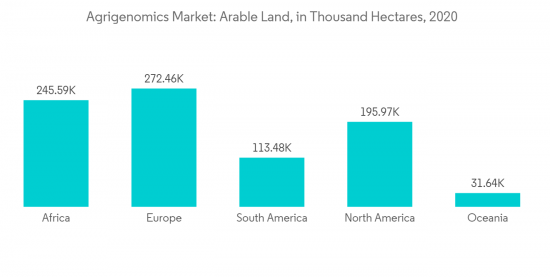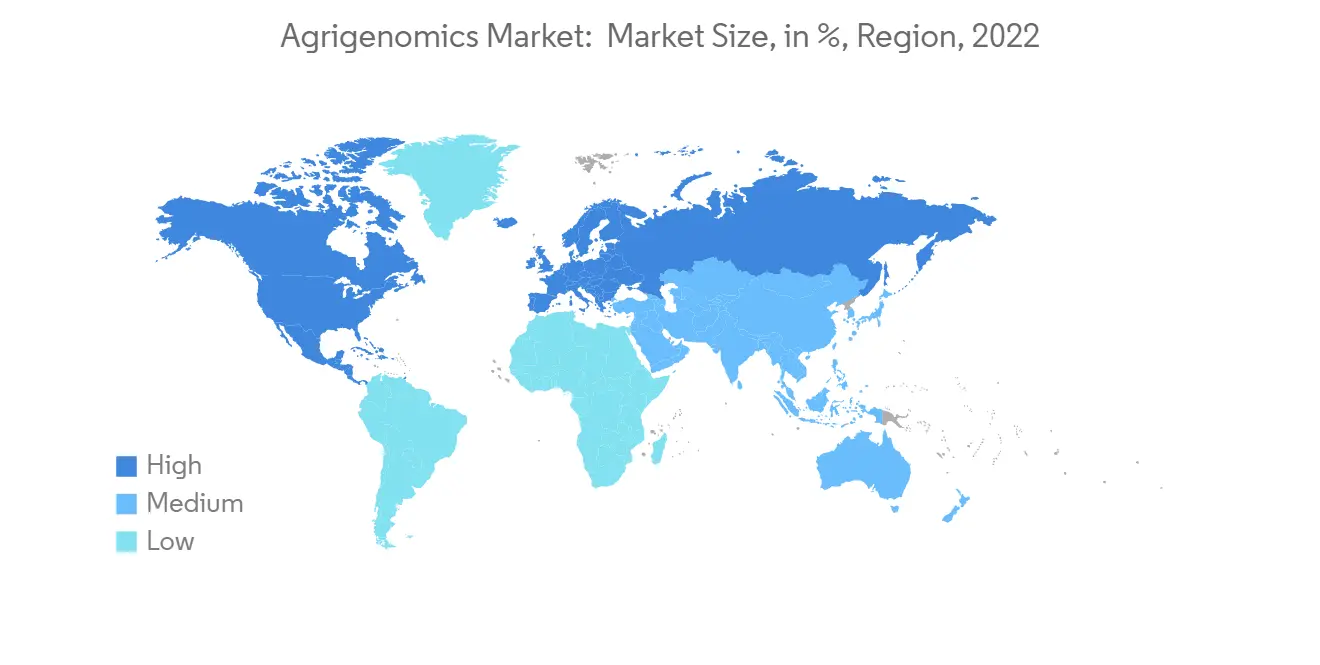 |
市場調査レポート
商品コード
1333714
アグリゲノミクス市場規模・シェア分析-成長動向と予測(2023年~2028年)Agrigenomics Market Size & Share Analysis - Growth Trends & Forecasts (2023 - 2028) |
||||||
● お客様のご希望に応じて、既存データの加工や未掲載情報(例:国別セグメント)の追加などの対応が可能です。 詳細はお問い合わせください。
| アグリゲノミクス市場規模・シェア分析-成長動向と予測(2023年~2028年) |
|
出版日: 2023年08月08日
発行: Mordor Intelligence
ページ情報: 英文 120 Pages
納期: 2~3営業日
|
- 全表示
- 概要
- 目次
アグリゲノミクス市場規模は、2023年の39億6,000万米ドルから2028年には61億米ドルに成長し、予測期間(2023-2028年)のCAGRは9.02%と予測されます。
主なハイライト
- アグリゲノミクスは、植物の遺伝子構成と遺伝子が作物生産にどのように寄与するかを研究するものです。マイクロアレイや次世代シーケンシング(NGS)技術は、育種家や研究者が植物や動物の遺伝的長所を評価・予測し、選抜や健康に関する重要な決定に情報を提供するのに役立っています。この調査は、収量の最適化、植物の進化、耐病性、系統関係、害虫駆除、ストレス耐性、食品やバイオ燃料の最適化を完全に理解することを目的としています。
- 日常的な農業活動におけるアグリゲノミクスの応用の高まり、デオキシリボ核酸/リボ核酸(DNA/RNA)シーケンスプロジェクト助成金の増加、ゲノミクスと農業における技術開発は、予測期間中の市場成長を促進すると予想される主な要因の一部です。世界のアグリゲノミクス市場の成長を支えるその他の要因としては、人口増加による食糧消費量の増加、ゲノム研究検査の高度なツールや技術の利用の拡大、政府出資機関による研究開発活動への投資の増加が挙げられます。
- イルミナの技術は、家畜や作物の高収量ゲノム開発のために、農業分野での普及が進んでいます。この技術により、研究者や育種家は、耐病性、生産性の向上、品質の改善など、望ましい形質の原因となる遺伝的変異を特定することができます。さまざまな生物のゲノムをシーケンスし、イルミナの技術を用いてデータを解析することにより、研究者はこれらの形質に関連する特定の遺伝子や遺伝マーカーを特定することができ、それを用いて作物や家畜の新しい改良系統を開発することができます。マイクロアレイおよび次世代シーケンサー(NGS)テクノロジーは、遺伝子型、遺伝子発現および制御、エピジェネティクスなど、動植物ゲノミクスのさまざまな側面の研究に有用です。これらのアプローチは、遺伝マーカーを評価し、形質や病気に関連する新しいマーカーを発見するのに必要なスループット、感度、精度を提供します。
- 家畜におけるゲノムシークエンシングの応用の増加は、親系統の研究を可能にするだけでなく、家畜にはびこる、あるいは家畜に寄生する細菌やウイルスなどの感染因子の特性の理解にも役立ちます。次世代シーケンサーの解像度により、研究者は感染因子の変異を経時的に調査することができ、これらの疾患の感染パターンの理解に役立つため、効果的な治療法の開発に貢献します。
アグリゲノミクス市場動向
食糧需要の増大と土地の縮小
- 世界人口は急速に増加しており、2050年には97億人に達すると予測されています。この人口増加に伴い、食糧需要も増加しており、農業部門はより多くの食糧を生産する必要に迫られています。しかし、農業は気候変動、土地の劣化、水不足、限られた資源など、いくつかの課題に直面しており、増大する食糧需要を満たすことは難しいです。
- 一方、工業化と都市化により、利用可能な耕地は世界の多くの地域で減少しています。したがって、需要を満たすためには、作物の生産性を向上させる必要があります。アグリゲノミクスの応用は、高収量の作物品種や畜産物の持続可能な解決策を開発することによって、作物の生産性を向上させました。
- 農家、育種家、研究者は、望ましい形質に関連する遺伝マーカーを容易に特定することができ、現代技術を用いた栽培や育種の決定に役立てることができます。害虫の攻撃と闘うために新しい植物技術が開発され続けているが、その一方で、害虫の新種や駆除が困難な系統の開発にもつながっています。菌類による主要作物の損失は、世界人口の9%近くを養うのに十分な量です。したがって、菌類は世界の食糧需要を満たすために農家がとる重要な戦略なのです。
- 国連食糧農業機関(FAO)によれば、多くの国々が、自然環境を保護し、食糧生産を多様化し、動植物の健康を守り、農作業の労力を軽減しながら、増加する世界人口を養うために持続可能な穀物を開発しています。遺伝資源は、家畜の繁殖と保護にとっても極めて重要です。そのため政府は、天然資源を管理し、動物遺伝資源を満たすための改良技術を開発しながら、公衆と動物の健康を守るための政策と基準の策定を支援しています。

北米が市場を独占
- 北米のアグリゲノミクス市場は、高収量品種の採用が増加しており、初期段階での抵抗力を高めることで有害な農薬の使用を減らすことができるため、着実な成長を遂げています。アグリゲノミクスにおけるジェノタイピングは、育種家や研究者に、複雑な遺伝形質に関連するマーカーを検出するための強力でコスト効率の高いツールを提供します。
- 米国農務省(USDA)の報告書によると、この地域ではトウモロコシ、綿花、大豆、カノーラ、テンサイなどの作物で、遺伝子組み換え(GE)種子品種の採用が拡大しています。例えば、除草剤耐性(HT)作物は、特定の広域除草剤(グリホサート、グルホシネート、ジカンバなど)に耐性を示します。昆虫抵抗性作物は、土壌細菌バチルス・チューリンゲンシス(Bt)の遺伝子を組み込んだもので、殺虫タンパク質を産生します。
- その他の遺伝子組み換え(GE)形質(ウイルスやカビに対する耐性、干ばつに対する耐性、タンパク質、油分、ビタミン含有量の強化など)も開発されているが、除草剤耐性(HT)形質とバチルス・チューリンゲンシス(Bt)形質が、米国の作物生産で最も一般的に使用されています。
- アグリゲノミクスの採用は、米国における農薬の使用を克服することが主な理由です。強力な研究開発と新技術の革新は、M&A活動の増加と相まって、この地域の市場成長を促進する主な要因となっています。米国で遺伝子組み換え作物が広く受け入れられているのは、収穫量の増加、農薬の使用量の削減、作物の品質向上といった利点が認識されているためです。
- おっしゃるとおり、米国ではトウモロコシ、大豆、綿花、カノーラ、テンサイの作付面積の90%以上が遺伝子組み換え作物です。米国農務省の報告によると、2020年には、米国内の大豆作物の94%が除草剤耐性に遺伝子組み換えされ、次いで綿花が83%、トウモロコシが10%となっています。

アグリゲノミクス産業の概要
アグリゲノミクス市場は適度に統合された市場であり、少数の主要企業が市場シェアの大半を占めています。Eurofins Scientific Se、Thermo Fisher Scientific Inc.、Illumina Inc.、Zoetis Inc.、Tecan Genomics, Inc.が調査対象市場の著名なプレーヤーです。新製品の発売、パートナーシップ、事業拡大は、主要企業が採用する主要戦略です。技術革新や事業拡大とともに、研究開発への投資や新規製品ポートフォリオの開発も、今後数年間は重要な戦略となりそうです。
その他の特典:
- エクセル形式の市場予測(ME)シート
- 3ヶ月間のアナリスト・サポート
目次
第1章 イントロダクション
- 調査の前提と市場定義
- 調査範囲
第2章 調査手法
第3章 エグゼクティブサマリー
第4章 市場力学
- 市場概要
- 市場促進要因
- 市場抑制要因
- ポーターのファイブフォース分析
- 供給企業の交渉力
- 買い手/消費者の交渉力
- 代替品の脅威
- 新規参入業者の脅威
- 競争企業間の敵対関係の強さ
第5章 市場セグメンテーション
- 技術分野
- リアルタイムPCR(qPCR)
- マイクロアレイ
- 次世代シーケンサー
- キャピラリー電気泳動
- その他のテクノロジー
- アプリケーション
- 作物
- 家畜
- サービス内容
- ジェノタイピング
- DNAフィンガープリンティング
- 遺伝的純度の評価
- 形質純度評価
- 遺伝子発現解析
- その他のサービス
- 地域
- 北米
- 米国
- カナダ
- メキシコ
- その他北米地域
- 欧州
- ドイツ
- 英国
- フランス
- ロシア
- スペイン
- その他欧州
- アジア太平洋
- 中国
- 日本
- インド
- その他アジア太平洋地域
- 南米
- ブラジル
- アルゼンチン
- その他南米
- 中東・アフリカ
- 南アフリカ
- その他中東とアフリカ
- 北米
第6章 競合情勢
- 市場シェア分析
- 合併・買収
- 企業プロファイル
- Eurofins Scientific Se
- Thermo Fisher Scientific'Inc
- Illumina'Inc.
- Zoetis'Inc.
- Neogen Corporation
- Galseq Srl Via Italia
- Agrigenomics'Inc.
- Biogenetic Services'Inc.
- Arbor Biosciences
- Tecan Genomics, Inc.
第7章 市場機会と今後の動向
The Agrigenomics Market size is expected to grow from USD 3.96 billion in 2023 to USD 6.10 billion by 2028, at a CAGR of 9.02% during the forecast period (2023-2028).
Key Highlights
- Agrigenomics is the study of plants' genetic makeup and how the genes contribute to crop production. Microarray and next-generation sequencing (NGS) technologies are helping breeders and researchers evaluate and predict genetic merit in plants and animals, informing crucial decisions about selection and health. The research aims to completely understand yield optimization, plant evolution, disease resistance, phylogenetic relationships, pest control, stress tolerance, and food and biofuel optimization.
- The rising applications of agrigenomics in routine agriculture activities, the increasing number of deoxyribonucleic acid/ribonucleic acid (DNA/RNA) sequencing project grants, and technological developments in genomics and agriculture are some of the key drivers expected to drive market growth during the forecast period. The other factors supporting the growth of the global agrigenomics market are the increasing food consumption volume due to the increasing population, the growing use of advanced tools and techniques of genome research testing, and rising investments in research & development activities by government-funded organizations.
- Illumina technology has become increasingly popular in agriculture for developing high-yielding genomics in livestock and crops. This technology enables researchers and breeders to identify genetic variations responsible for desirable traits, such as disease resistance, increased productivity, and improved quality. By sequencing the genomes of various organisms and analyzing the data using Illumina technology, researchers can identify specific genes and genetic markers associated with these traits, which can then be used to develop new and improved strains of crops and livestock. Microarray and next-generation sequencing (NGS) technologies are useful for studying various aspects of plant and animal genomics, including genotype, gene expression and regulation, and epigenetics. These approaches offer the throughput, sensitivity, and precision needed to evaluate genetic markers and discover new ones associated with traits or diseases.
- The increase in applications of genome sequencing in livestock not only enables the study of parent lineage but also aids in understanding the characteristics of infectious agents, such as bacteria and viruses that infest them or live on them. The resolution of the next-generation sequencing enables researchers to study the mutations in infectious agents over time, and help in understanding the transmission patterns of these diseases, thereby contributing to the development of effective treatment.
Agrigenomics Market Trends
Growing Food Demand and Shrinking Land
- The global population has been increasing rapidly and is projected to reach 9.7 billion by 2050. With this increase in population, there is also a growing demand for food, which has put pressure on the agricultural sector to produce more food. However, the agriculture industry faces several challenges, including climate change, land degradation, water scarcity, and limited resources, making it difficult to meet the increasing demand for food.
- On the other hand, due to industrialization and urbanization, the available arable land is decreasing in many regions globally. Hence, increasing crop productivity is needed to meet the demands. The application of agrigenomics increased crop productivity by developing high-yielding crop varieties and sustainable solutions for livestock products.
- Farmers, breeders, and researchers can easily identify the genetic markers linked to desirable traits, informing cultivation and breeding decisions using modern technology. Although new plant technologies are continuously being developed to fight pest attacks, they are also leading to the development of new and difficult-to-kill strains of pests. The losses in major crops due to fungi are enough to feed nearly 9% of the global population. Thus, it is the key strategy farmers adopt to meet global food demand.
- According to the Food and Agriculture Organization (FAO), many countries are developing sustainable grains to feed the growing world population while safeguarding the natural environment, diversifying food production, protecting plant and animal health, and reducing the drudgery of farming. Genetic resources are also crucial to livestock breeding and protection. Therefore, the government supports the development of policies and standards to protect public and animal health while managing natural resources and developing improved technologies to meet animal genetic resources.

North America Dominates the Market
- The North American agrigenomics market is experiencing steady growth due to the increasing adoption of high-yielding varieties, as they can reduce the usage of harmful pesticides by enhancing the resistant power during the initial stages. Genotyping within agrigenomics provides breeders and researchers powerful, cost-effective tools to detect markers associated with complex genetic traits.
- According to the United States Department of Agriculture (USDA) report, the greater adoption of genetically engineered (GE) seed varieties in crops like corn, upland cotton, soybeans, canola, and sugarbeets is witnessed in the region. For instance, herbicide-tolerant (HT) crops tolerate specific broad-spectrum herbicides (such as glyphosate, glufosinate, and dicamba). Insect-resistant crops contain a gene from the soil bacterium Bacillus thuringiensis (Bt) that produces an insecticidal protein.
- Although other genetically engineered (GE) traits have been developed (such as virus and fungus resistance, drought resistance, and enhanced protein, oil, or vitamin content), herbicide-tolerant (HT) and Bacillus thuringiensis (Bt) traits are the most commonly used in US crop production.
- The adoption of agrigenomics is majorly attributed to overcoming the usage of pesticides in the United States. Strong R&D and innovation of new technologies, coupled with the increasing merger and acquisition (M&A) activities, are the major factors fueling the region's market growth. The greater acceptance of genetically modified (GMO) crops in the United States is a result of their perceived benefits, such as increased yields, reduced use of pesticides, and improved crop quality.
- As you mentioned, more than 90 percent of the corn, soybean, cotton, canola, and sugar beet acreage in the United States is genetically modified. As per the USDA report, in 2020, 94% of the soybean crops in the United States were genetically modified to be herbicide tolerant, followed by cotton, accounting for 83%, and corn, accounting for 10%.

Agrigenomics Industry Overview
The agrigenomics market is a moderately consolidated market, with a few key players holding a majority of the market share. Eurofins Scientific Se, Thermo Fisher Scientific Inc., Illumina Inc, Zoetis Inc, and Tecan Genomics, Inc. are the prominent players in the market studied. New product launches, partnerships, and expansions are the major strategies the leading companies adopt. Along with innovations and expansions, investments in R&D and developing novel product portfolios will likely be crucial strategies in the coming years.
Additional Benefits:
- The market estimate (ME) sheet in Excel format
- 3 months of analyst support
TABLE OF CONTENTS
1 INTRODUCTION
- 1.1 Study Assumptions and Market Definition
- 1.2 Scope of the Study
2 RESEARCH METHODOLOGY
3 EXECUTIVE SUMMARY
4 MARKET DYNAMICS
- 4.1 Market Overview
- 4.2 Market Drivers
- 4.3 Market Restraints
- 4.4 Porter's Five Forces Analysis
- 4.4.1 Bargaining Power of Suppliers
- 4.4.2 Bargaining Power of Buyers/Consumers
- 4.4.3 Threat of Substitute Products
- 4.4.4 Threat of New Entrants
- 4.4.5 Intensity of Competitive Rivalry
5 MARKET SEGMENTATION
- 5.1 Technology
- 5.1.1 Real-Time PCR (qPCR)
- 5.1.2 Microarrays
- 5.1.3 Next Generation Sequencing
- 5.1.4 Capillary Electrophoresis
- 5.1.5 Other Technologies
- 5.2 Application
- 5.2.1 Crops
- 5.2.2 Livestocks
- 5.3 Service Offerings
- 5.3.1 Genotyping
- 5.3.2 DNA Fingerprinting
- 5.3.3 Assessment of Genetic Purity
- 5.3.4 Trait Purity Assessment
- 5.3.5 Gene Expression Analysis
- 5.3.6 Other Service Offerings
- 5.4 Geography
- 5.4.1 North America
- 5.4.1.1 United States
- 5.4.1.2 Canada
- 5.4.1.3 Mexico
- 5.4.1.4 Rest of North America
- 5.4.2 Europe
- 5.4.2.1 Germany
- 5.4.2.2 United Kingdom
- 5.4.2.3 France
- 5.4.2.4 Russia
- 5.4.2.5 Spain
- 5.4.2.6 Rest of Europe
- 5.4.3 Asia Pacific
- 5.4.3.1 China
- 5.4.3.2 Japan
- 5.4.3.3 India
- 5.4.3.4 Rest of Asia-Pacific
- 5.4.4 South America
- 5.4.4.1 Brazil
- 5.4.4.2 Argentina
- 5.4.4.3 Rest of South America
- 5.4.5 Middle East and Africa
- 5.4.5.1 South Africa
- 5.4.5.2 Rest of Middle East and Africa
- 5.4.1 North America
6 COMPETITIVE LANDSCAPE
- 6.1 Market Share Analysis
- 6.2 Mergers & Acquisitions
- 6.3 Company Profiles
- 6.3.1 Eurofins Scientific Se
- 6.3.2 Thermo Fisher Scientific' Inc
- 6.3.3 Illumina' Inc.
- 6.3.4 Zoetis' Inc.
- 6.3.5 Neogen Corporation
- 6.3.6 Galseq Srl Via Italia
- 6.3.7 Agrigenomics' Inc.
- 6.3.8 Biogenetic Services' Inc.
- 6.3.9 Arbor Biosciences
- 6.3.10 Tecan Genomics, Inc.
